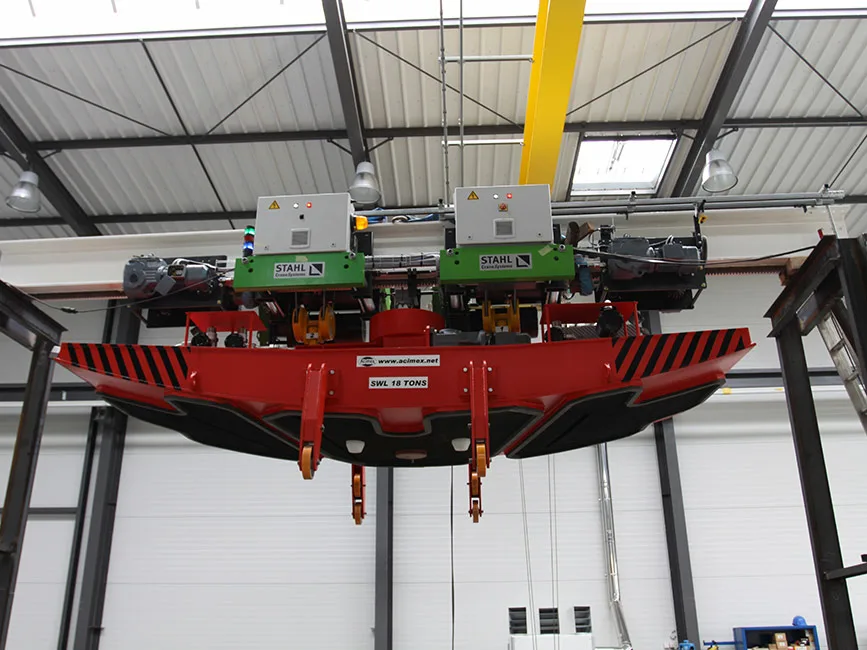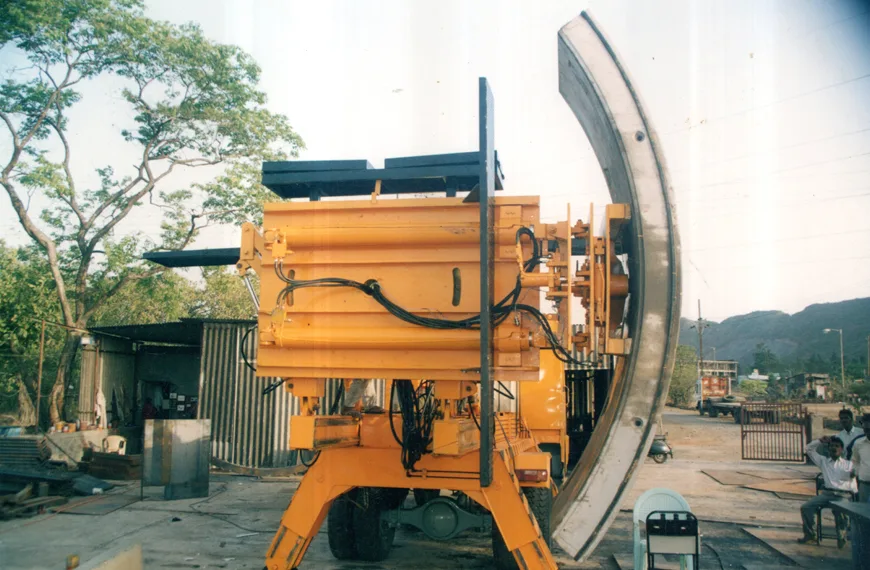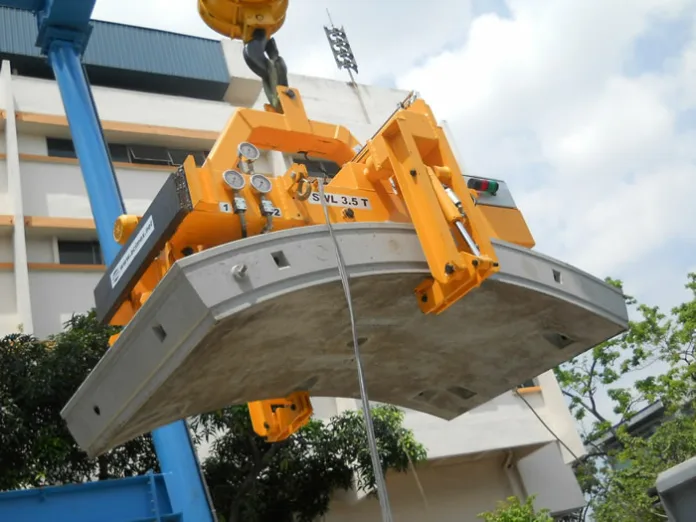Segmental erector machines are advanced construction equipment used to lift, position, and assemble precast concrete segments in large-scale infrastructure projects. By facilitating the handling of heavy segments with minimal manual intervention, they significantly enhance operational efficiency. Their automated operation streamlines the segment erection process, allowing to meet tight project deadlines while maintaining high safety standards.
Where is it used?
- Bridges
- Viaducts
- Tunnels
- Elevated Railways
- Flyovers and Overpasses
The components of segmental erectors includes:
- Base Frame: Provides structural support and stability.
- Lifting Mechanism: Hydraulic or mechanical system for lifting segments.
- Rotation System: Enables segment rotation for proper alignment.
- Control System: Manages machine functions and operations.
- Safety Devices: Sensors and emergency features for safe operation.
- Transport System: Tracks or wheels for site mobility.
- Segment Grippers: Attachments for securely holding precast segments.
How does Segmental Erectors work?
Segmental erectors work through a series of coordinated processes that enable the precise lifting, positioning, and assembly of precast concrete segments. Here’s an overview of how they operate:
- Preparation: The site is prepared, and segments are transported to the erection area.
- Lifting Segments: The hydraulic or mechanical lifting mechanism raises the precast segment.
- Positioning: The segment is moved and rotated into the desired position.
- Alignment and Guidance: Horizontal and vertical guides ensure accurate alignment with adjacent segments.
- Erection: The segment is lowered and securely placed, often using grippers to hold it in position.
- Securing the Segment: The segment is fastened in place for stability.
- Repeat Process: The steps are repeated for each subsequent segment until the structure is complete.
Advantages of segmental erectors:
- Speeds up the construction process by automating segment placement.
- Ensures accurate alignment and positioning of precast segments.
- Minimizes manual labour requirements, lowering overall project costs.
- Reduces risks associated with manual lifting and positioning.
- Allows for construction in tight spaces with less impact on traffic and surrounding areas.
- Capable of handling heavy segments with ease.
- Facilitates uniform installation of segments, contributing to structural integrity.
- Accelerates timelines, enabling earlier project handover.
- Precise handling minimizes damage to precast segments.
- Streamlines the transportation and assembly of segments on-site.
- Can be customized for different project requirements and site conditions.


Types of Segmental Erectors
1. Single-Cantilever Erectors
Single-cantilever erectors are specifically designed for erecting precast concrete segments in a cantilever fashion, which allows for extended overhangs without the need for scaffolding. This type of erector features a horizontal arm that extends from a support point, enabling the assembly of segments at a distance from the main structure. The primary advantage of single-cantilever erectors is their ability to significantly reduce labour costs and construction time since scaffolding is not required. These erectors are often used in bridge construction, where extended spans are essential, facilitating efficient operations over water or difficult terrain while ensuring stability with a minimal footprint on the ground.
2. Twin-Cantilever Erectors
Twin-cantilever erectors features two cantilever arms that allow for the simultaneous erection of segments on both sides of the main structure. This design maximizes productivity and efficiency, enabling the quick completion of large projects. The significant advantages of twin-cantilever erectors include reduced construction time and improved safety, as segments can be placed without the need for additional support structures. Commonly used in constructing large bridges and viaducts, these erectors ensure balanced placement on both sides, and their robust design can handle heavy segments while maintaining precise alignment throughout the erection process.
3. Rail-Mounted Erectors
Rail-mounted erectors operate on tracks laid alongside the construction site, providing a stable and guided path for the movement of the equipment. This type of erector is highly effective for large infrastructure projects where segments need to be transported over long distances. The advantages of rail-mounted erectors include high mobility, precise control, and the capacity to handle heavy precast segments. They are particularly valuable in bridge and viaduct construction, where continuous movement along the track enhances productivity and efficiency. Additionally, their design allows for easy transportation of segments from the staging area to the erection site, minimizing downtime and logistical challenges.
4. Self-Launching Erectors
Self-launching erectors are innovative machines designed to move along the structure they are building, effectively eliminating the need for cranes or additional lifting equipment. This unique design enables the erector to “launch” itself into position as segments are placed, providing an efficient and streamlined erection process. The primary advantages of self-launching erectors include increased safety, as they reduce reliance on external lifting equipment, and enhanced mobility, allowing for adaptability to various construction conditions. These erectors are especially useful in elevated railway and bridge projects, where access can be limited, and fast-paced construction is crucial.
5. Modular Erectors
Modular erectors consist of interlocking components that can be reconfigured for different projects and construction needs. This flexibility allows them to be tailored to specific site requirements and project specifications. The advantages of modular erectors include adaptability, cost-effectiveness, and reduced assembly time, making them ideal for projects with varying segment sizes or construction layouts. They are particularly beneficial in urban areas where space is constrained. Their ability to be easily transported and assembled on-site enhances their versatility, accommodating diverse construction applications while maintaining efficiency.
6. Heavy-Duty Erectors
Heavy-duty erectors are engineered to handle larger and heavier precast segments, making them suitable for substantial infrastructure projects, such as major bridges and high-rise buildings. Their robust construction and powerful lifting mechanisms allow them to safely and efficiently erect heavy segments without compromising structural integrity. The advantages of heavy-duty erectors include the capability to support high load capacities and increased reliability in challenging environments. These erectors are frequently used in large-scale civil engineering projects, where their strength and durability are essential for meeting stringent safety standards and ensuring long-term performance.
Conclusion
Segmental erectors are essential in modern infrastructure projects, enabling the efficient and precise assembly of precast concrete segments for bridges and viaducts. As the demand for infrastructure grows, leveraging advanced segmental erection technologies will be important for meeting engineering challenges and building resilient structures that support future development.
Image Source: acimex.net, constrosystems.in,

